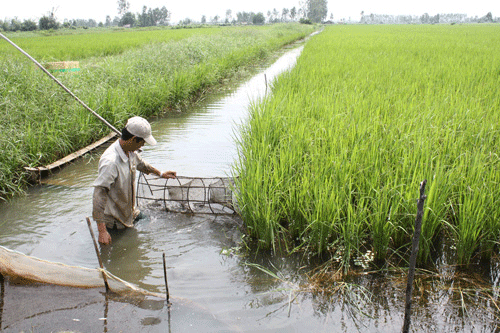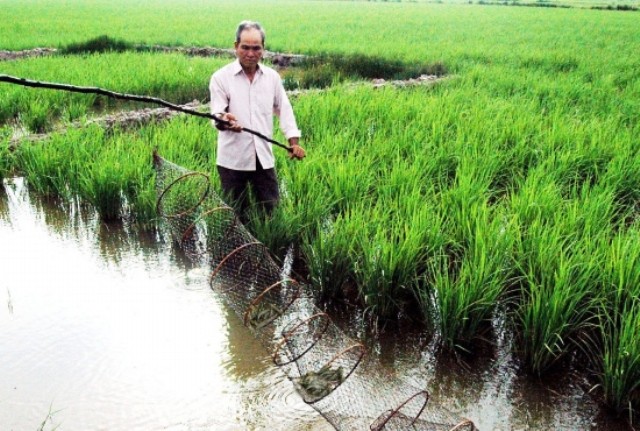(VOVworl) – In the last five years, the dual rice-shrimp farming systems has grown in many Mekong Delta provinces from tens of thousands of hectares in 2005 to 160,000 ha in 2011 and is likely to reach 200,000 ha by 2020. The model has proven effective and sustainable.
 |
The rice-shrimp farming model has resulted in high economic efficiency for farmers.
(Photo: Huynh Su/VNA) |
The Mekong Delta has many advantages for developing rice-shrimp farming, which is more environmentally friendly than other models due to easy application of advanced management methods, less use of chemicals, and conformity to good agricultural practices (GAP).
In addition to the key products, which are rice and shrimp, other crops and aquatic products can be alternately farmed under the model, which has profits of up to 30% higher than shrimp or rice farming alone.
Hoi Van Thu, a farmer from Phong Tan commune in Bac Lieu province, has cultivated rice and raised shrimps simultaneously.
He said:“In the last five years, regulating saline zones and fresh zones in my locality hasn’t been stable. Much salt intrusion has made it impossible for rice to be sowed in the fields. That’s why the rice-shrimp farming model has increased economic efficiency”.
Rice cultivation in shrimp raising areas is a way to remove salt from the rice fields during the rainy season, limit salt intrusion, and prolong the life-span of land use.
 |
The rice-shrimp farming model has proven effective in Bac Lieu province.
(Photo: Bac Lieu newspaper) |
Ca Mau and Bac Lieu are among the Mekong provinces with large rice-shrimp farms, master-planning and development directions until 2020, and solutions for developing the model sustainably.
Soc Trang has master-planned rice-growing areas on shrimp farms that produce Ngoc Dong brand fragrant rice in accordance with GlobalGAP standards.
Tra Vinh, which is famous for rice-shrimp farming on Long Hoa island in the middle of the Tien River, has successfully established organic rice cultivation areas for high-end export markets.
Dr Tran Van Khoi, Director of the National Agricultural Promotion Center, says the rice-shrimp farming model now typifies Mekong Delta coastal areas.
“First, provinces have done regional master-planning in line with detailed directions from the government and the Ministry of Agriculture and Rural Development for each province. Second, with the available resources, provinces should focus on the transfer of technology, especially training to improve farmers’ production skills so that the model can develop sustainably. Third, we need to encourage farmers to promote product brand,” according to Mr. Khoi.
The rice-shrimp production scale in the Mekong Delta could reach 200,000 ha, contributing about 800,000 tons of rice a year. The Ministry of Agriculture and Rural Development plans to develop an irrigation system for the model.